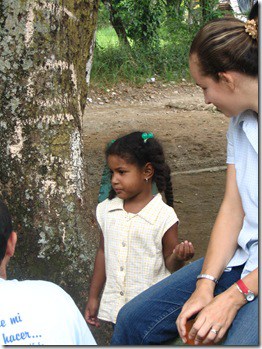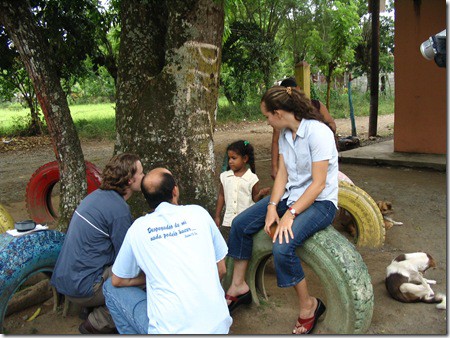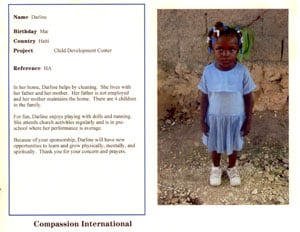A Smart Risk
Shaun Groves wrote this post. It’s been approved by the powers-that-be.
Be careful going around having ideas and talking about them. You might just get put to work. That’s what happened to me.
About a year ago, I think it was, I started talking to the folks at Compassion about a crazy new idea. I wondered if they could spread the word about their ministry to children through bloggers the way the Compassion message has been spread through artists and speakers for decades. I proposed Compassion take bloggers on a trip to see the ministry for themselves and, of course, ask them to blog about what they see.
When the powers-that-be decided the idea was worth trying out, a small team went to work finding the right bloggers to travel to Uganda. Then we took a very long flight to Africa together back in February, deplaned and played with children, and learned about the needs of Ugandans and how Compassion and sponsors are partnering to meet them. And we blogged. With very slow connection speeds, we blogged.
We posted pictures, stories, videos and lots of links to compassion.com. Thousands read along daily. Hundreds of children were released from poverty and hundreds of Americans were released from wealth as a result. And the Web lit up with applause.
My favorite online compliment came from a fund-raising expert who wrote:
“Looked at with old economy eyes, Compassion is taking a huge risk, letting go of its marketing to 15 different near-strangers who might do anything. Looked at with modern eyes, Compassion is smart: willing to give up control in favor of being talked about by real people.”
In other words, some institutions would call this kind of idea crazy but it worked: People are talking about children, about loving them, about perspective and grace and kindness and Jesus.
Now, when I’m not singing or speaking (or blogging), I’m working part time these days for Compassion – developing more and better relationships with bloggers.
We just launched CompassionBloggers.com where anyone can read the best posts from our blogging trips, and where bloggers can go to grab widgets and banners, apply to go on a blogging trip with us, or sign up to receive a monthly blogging assignment from Compassion.
Our ranks are growing. There are now a few hundred bloggers scattered around the world blogging on behalf of Compassion every month.
What’s next? We’re taking a bunch of bloggers to the Dominican Republic Nov. 2-7, so read along that week and pray that we assemble the right gifted team for the trip, that we’re safe and healthy while overseas, that readers are inspired and mobilized to act, and that the blogosphere is filled with talk of children and Jesus once again.
Continue Reading ›Maybe Next Time, a Smile
I knew that she was a sweet little girl, but it wasn’t her face that told me so. Her face had a hard look, as if smiling was an indulgence; something reserved for close friends and family only. But the hardness in her face wasn’t a frown. It wasn’t unhappiness I saw there. It might have simply been shyness and uncertainty.
After all, who was I? Some American who swooped in to pass around the good feelings before returning to vast shelters of wood, composite and stone? Someone who wanted to “do little good” and make himself feel better before returning to his consumer Christianity?
It’s possible all of this was on her face and in her four-year-old mind. Children are, after all, very perceptive.
But maybe I was projecting. Maybe my mind was simply painting my own guilt on her stoic face.
I stood in the courtyard playground of that child development center in Bonao, hours outside of Santo Domingo and less than a day after arriving in the Dominican Republic (DR), and the sun’s heat felt more like that given off by an interrogation lamp than life-giving warmth.
Why was I really here anyway?
I came to the DR to lead a men’s retreat with three others. Two other Compassion employees and one elder of a local church. Our host was an employee of the DR country office. The next day, we were to begin speaking at his church and leading what we hoped would be a revival for the men of Santo Domingo.
So I was there to speak. To challenge, encourage and uplift.
But even more, I discovered that I was there to listen. And to be challenged, encouraged and uplifted myself.
Our first day in the country was a Compassion day. A chance for three of us to see, for the first time, the results of the work of thousands around the globe working to further the cause of Christ.
It was a holiday in the Dominican Republic, so we didn’t receive the 300-child welcoming party I’d heard is often customary when visiting a Compassion child development center.
Instead, we were greeted by a handful of children. Several boys and, as I remember it, one little girl with a hard face, but who radiated sweetness nonetheless.

But from where? I wonder now what drew me so strongly to this sweet child, only present that day because her mother, Rosa, is their volunteer cook.
Perhaps it was the English.

Shortly after meeting Ana Maria, I knelt down to speak with her, with our friend and translator, David, at my right.
“Hello Ana. My name is Brandon.”
And before David could translate, she spoke.
“Hello,” she said, in English. There was a softness in her voice, one that smoothed her features and melted my heart.
“God bless you, Ana,” I said.
“God bless you,” she replied, again without waiting for David to translate. The center facilitator, who was sitting nearby, smiled.
“She wants to learn English.”
“That’s wonderful.” I looked back at Ana Maria and smiled at her.
She didn’t smile back, but the hardness I had seen at first was gone. Better yet, the image of hardness I projected on her face at the first was replaced with hope.
Cautious hope. And a desire to smile, but maybe not just yet.
Ana didn’t have a sponsor before that day. But by the time I left, she did.
I wonder sometimes if she remembers meeting me. If she recalls meeting an American man who would return home in days and slide unwittingly back into Western and indulgent living, but who now had a lifeline to need, reality and truth. A lifeline that somehow sustains both the giver and receiver.
I hope she does remember. Two years from now, my wife and I plan to return to the DR to visit Ana Maria and her mother. My wife will meet them for the first time, and I will see them once again. We’ll hug, pray, play and speak English and Spanish to each other.
And maybe, just maybe, we’ll smile.
Brandon Satrom is the Enterprise Applications Architect for Compassion. He works in IT evaluating both new and emerging technologies and helping Compassion IT make the best use of existing technologies.
Continue Reading ›Why Me, God?
For about 35 years, once I first heard of such a possibility, I wanted to sponsor a child. But for most of that time, I simply could not afford even $10 per month.
About mid-2001, watching a commercial on TV for another organization, I realized I could finally afford to do something. But through which organization? Who could I really count on to use the money for the child’s benefit? Could I trust any of them, and how would I know? Having no answers, I did nothing.
I spent all of 2002 praying for God to show me what area of ministry He wanted me in. Almost every Sunday, I heard, “Find your passion and use it!” “Hmm…where can I get a ‘passion’?” I couldn’t have found a passion in me with a flashlight or a search warrant. So I prayed, and I waited.
Two weeks before Christmas, I walked out of church on a cold, gray day in a mood to match. I walked down three or four steps into the fellowship area and began to pass a row of ministry tables. Above and behind the first one was a banner saying something about Compassion.
I kept walking, but my inner skeptic wanted to know: “What are we being ‘compassionate’ about, today?”
 I turned, looked down at a sea of packets, each with a photo of a child; the world stopped, along with all sound and movement around me. I knew what these packets represented.
I turned, looked down at a sea of packets, each with a photo of a child; the world stopped, along with all sound and movement around me. I knew what these packets represented.
I stood there, saying half under my breath, “I can do this! I can do this!” About the fourth time, a Voice inside said, “Yes, you can do this. This is it!”
A warmth started at the top of my head and flowed over me and through me, right down to my feet. I took home two packets, unsure about one child.
That afternoon, I went to Compassion’s website to look at more children. I didn’t realize how many photos they kept on there, and I quickly felt overwhelmed. “God, I can’t sponsor them all!” soon changed to “God, we’ve got to find sponsors for these kids!”
About the fourth time (what is it with four times?!), I heard, “Yes, we do!” Then I realized the “This is it” meant more for me than “merely” sponsoring. And I do not mean to minimize the importance of sponsoring!
So, as is true of so many advocates, if not all, I came into this ministry with a clear calling. There have been times when I have needed to remember that, when church doors refused to open, when people walked by the tables with hardly a glance, and I wanted to use a 2×4 on their heads to get their attention. (Thank God, I’ve grown past that!)
But let me mention some of the things that continually reaffirm the rightness of Compassion in my life, and as a real ministry in this world. (more…)
Using Technology to Fight Poverty
So when you think Compassion International, the first thing you think is “technology” right?
What?!? You don’t?
Me neither. When I think of Compassion, I think of the three wonderful children my wife and I sponsor. I think about the first time I met Ana Maria, our little girl from the Dominican Republic. I think about the thousands of professions of faith Compassion reports each quarter and the amazing leaders emerging from our Leadership Development Program. I think about impact. About lives changed. About the chance we all have to eliminate poverty in my lifetime.
So yeah, I’ll admit it, I don’t think “technology” when I think Compassion. Not at first, even though I work in Information Technology (IT).
And that makes sense. Compassion is about releasing children from poverty in Jesus’ name. The goal of Information Technology is to support that goal, not replace it. Compassion has always expressed a great commitment to using technology in ways that support our mission, and the IT organization has enabled Compassion to fulfill its mission in countless ways.
And while that will continue to be true for many years to come, technology today is about so much more than servers and software and applications built by IT shops. In my opinion, technology in the 21st century is about community. About giving people a global voice. About connecting people across the city and across the globe. About enabling people to experience life lived beyond their borders.
Community. Now that’s right up Compassion’s alley.
And what amazes and inspires me the most about modern technology is how it enables you to do amazing things for Compassion and other causes around the world.
I look at Facebook, where Roderick Pitts, a student from Tupelo, Miss., created a cause page for Compassion. As of today, that cause has nearly 27,000 members and has raised almost $2,700 for Compassion. The cost to Compassion was zero, because Roderick found a way to use technology to fight poverty.
I look at the Uganda Blogging trip, now drawing to a close. Fifteen popular bloggers given an opportunity to see our work firsthand. These 15 individuals were changed by the experience to be sure, but their posts, pictures and videos have resulted in a change for thousands of their readers as well. Many of their readers have sponsored a child. Many now see poverty in a new light. Many will join Compassion to stand up and fight, because these 15 individuals found a way to use technology to fight poverty.
Compassion is by no means alone. Programs like One Laptop per Child (OLPC), Kiva.org and sites like Freerice are not just raising our awareness of global poverty, they are doing something more. They are doing something about global poverty by providing you and me with opportunities to join the fight.
And that’s how I look at my job in Compassion IT: using technology to fight poverty.
It’s a theme I am passionate about and one I hope to visit often as a contributor to this blog. But I need your help. I want us to dialogue together about technology and poverty. I want to hear your ideas and experiences.
Basically, I am asking for feedback, either in the comments of this post, or on your own blogs. How do you see technology being used to fight poverty? What ideas do you have for how Compassion can use technology to fight poverty? How do you use technology in your mission?
It’s a great time to be at Compassion. I’m looking forward to our dialogue.
Brandon Satrom is the Enterprise Applications Architect for Compassion. He works in IT evaluating both new and emerging technologies and helping Compassion IT make the best use of existing technologies.


